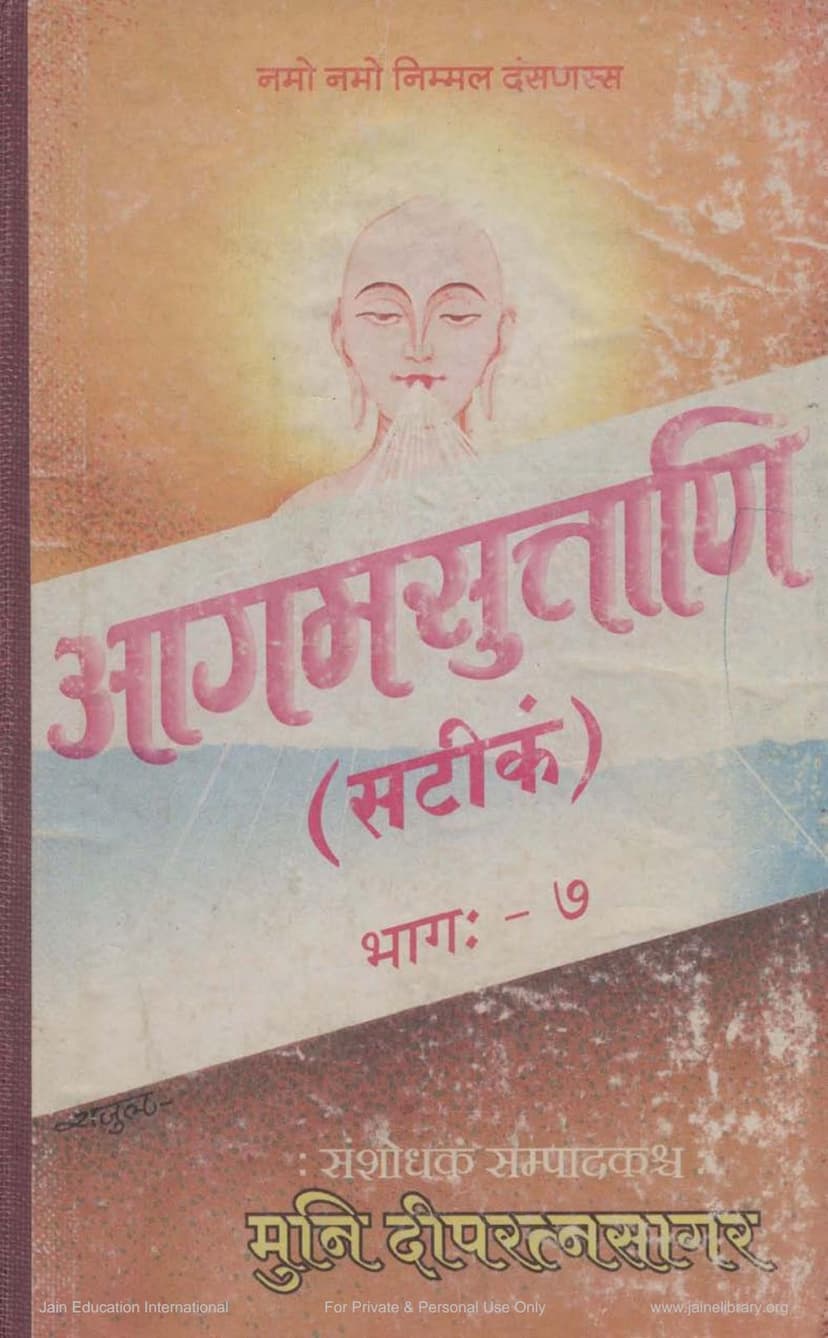Agam Sutra Satik 09 Anuttaropapatikdasha AngSutra 09
Added to library: September 1, 2025

Summary
Here's a comprehensive summary of the Jain text "Agam Sutra Satik 09 Anuttaropapatikdasha AngSutra 09," based on the provided pages:
Title: Agam Sutra Satik 09 Anuttaropapatikdasha AngSutra 09 (आगमसुवाणि (सटीकं) नवमं अङ्गसूत्रम्)
Author/Editor: Muni Deepratnasagar (संशोधकः सम्पादकश्चः मुनि दीपरत्नसागर)
Publisher: Agam Shrut Prakashan (आगम श्रुत प्रकाशन)
Core Content:
This volume is part of a larger series called "Agam Sutra Satik" (आगमसुवाणि (सटीकं)), which aims to provide detailed commentary on various Jain Agamas. Specifically, this book focuses on the Anuttaropapatikadashanga Sutra (अनुत्तरोपपातिकदशाङ्गसूत्रं), which is the ninth Anga Sutra in the Jain canon.
The text includes the original sutras (मूलसूत्रम्) and the commentary by Acharya Abhaydevsuriji (अभयदेवसूरिविरचिता वृत्तिः).
Structure and Key Sections:
The book is organized into sections based on the structure of the Anuttaropapatikadashanga Sutra, which is divided into categories called "Vargas" (वर्ग) and within each Varga, there are "Adhyayanas" (अध्ययन).
- Varga-1 (वर्ग:-१): This Varga contains 10 Adhyayanas.
- Adhyayana-1 (अध्ययन-१): This is the primary focus of the provided pages. It details the lives of individuals who attained birth in the highest celestial realms (Anuttara Vimanas).
- It begins with an invocation and then presents a dialogue between Lord Mahavir and his disciple Gautama Swami, discussing the structure of the Anuttaropapatikadashanga Sutra.
- The first Adhyayana describes the story of Jali Kumar (जाली कुमार). It details his renunciation, ascetic practices, and eventual rebirth in a celestial abode, specifying his lifespan.
- The text explains the journey and rebirth of Jali Kumar, highlighting the consequences of his actions.
- It also briefly mentions that the remaining nine Adhyayanas in this Varga follow a similar pattern, describing the lives and destinies of other individuals.
- Adhyayana-1 (अध्ययन-१): This is the primary focus of the provided pages. It details the lives of individuals who attained birth in the highest celestial realms (Anuttara Vimanas).
- Varga-2 (वर्ग:-२): This Varga contains 13 Adhyayanas.
- The text outlines the structure of this Varga and mentions that it also deals with celestial rebirths.
- It lists the names of the individuals whose stories are narrated in these 13 Adhyayanas, such as Deepasain, Mahasen, Latdanta, etc.
- The summary indicates that the ascetics in this Varga also undergo a period of monastic practice before their celestial rebirths.
- Varga-3 (वर्ग:-३): This Varga contains 10 Adhyayanas.
- This Varga introduces stories of individuals who achieved significant spiritual merit.
- Adhyayana-1 (अध्ययन-१): This Adhyayana details the life and practices of Dhanya (धन्ने), a wealthy merchant's son.
- It describes his renunciation and extreme ascetic practices, including fasting and severe penances.
- The text vividly portrays Dhanya's emaciated physical state due to his austerities, describing the extreme leanness and visibility of his bones and skin.
- It recounts his interactions with King Senia and his mother, and his eventual attainment of celestial rebirth after his death.
- The commentary emphasizes the arduous nature of his penances and his ultimate spiritual achievement.
- The text then moves on to Sunakshatra (सुणक्खत्ते), another individual whose story is detailed in this Varga, highlighting his renunciation and asceticism.
- It further mentions that the remaining Adhyayanas in Varga-3 follow a similar pattern, describing the lives and spiritual journeys of other individuals.
Key Themes and Concepts:
- Celestial Rebirths (Anuttara Upapata): The primary theme of the Anuttaropapatikadashanga Sutra is the description of individuals who are reborn in the highest celestial realms (Anuttara Vimanas) after a life of intense spiritual practice and virtuous deeds in the human realm.
- Asceticism and Penance (Tapa, Kayotsarga): The text emphasizes the importance of severe ascetic practices, renunciation, and self-discipline as the means to attain such elevated rebirths. Descriptions of extreme fasting and physical emaciation highlight the dedication of these ascetics.
- Karma and Rebirth: The stories illustrate the principles of karma, where actions in this life directly influence future rebirths. The purity of conduct and the intensity of penance lead to rebirths in the highest planes of existence.
- Spiritual Journey: The narrative follows the spiritual journeys of individuals from worldly life to renunciation, asceticism, and ultimately, celestial rebirth.
- Commentary (Vritti): The inclusion of Abhaydevsuriji's commentary provides detailed explanations of the sutras, their context, and the philosophical underpinnings.
- Structure of the Jain Canon: The introductory pages and the table of contents highlight the placement of the Anuttaropapatikadashanga Sutra within the larger structure of the Jain Agamas, specifically as the ninth Anga Sutra. It also lists other Angas and Upangas discussed in the series.
Overall Purpose of the Text:
The "Agam Sutra Satik 09 Anuttaropapatikdasha AngSutra 09" serves to:
- Educate: Provide a detailed understanding of the Anuttaropapatikadashanga Sutra and its teachings.
- Inspire: Illustrate the profound results of dedicated spiritual practice and asceticism, motivating readers towards similar paths.
- Preserve: Present the original Jain scriptures along with authoritative commentaries, ensuring the preservation and transmission of Jain wisdom.
- Guide: Offer insights into the nature of celestial realms and the path to attaining them through virtuous living and spiritual discipline.
The text is a scholarly and spiritual work, offering both the original Jain scriptural content and the invaluable insights of a prominent commentator, making it a significant resource for the study of Jainism.